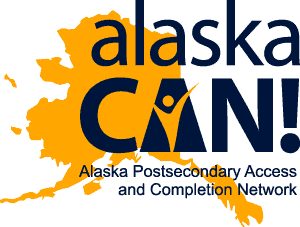Alaska
Research Presentations
- Where Next for Postsecondary Education in Alaska – Nate Johnson, PhD, Founder & Principal Consultant; Postsecondary Analytics
- APS Strategic Listening Session: Alaska Performance Scholarship Program Review and Recommendations – McKinley Research Group, LLC.
- Alaska Postsecondary Access & Completion Inventory Presentation – Scott Miller, MPPM, Senior Consultant; McDowell Group, LLC.
- Getting to 65 by 2025: Understanding the Demographic Landscape – Dan Robinson, Research Chief; Alaska DOLWD, Research and Analysis
- Looking Ahead to 2020: Occupational Projections and Training Needs – Dan Robinson, Research Chief; Alaska DOLWD, Research and Analysis
- College Access and Success in Alaska: Data Analysis – Patrick Kelly; National Center for Higher Education Management Systems (NCHEMS)
Publications
National
Here is a list of research and reports that provide further evidence about the importance of a postsecondary education completion.
- The State of Higher Education 2023 Report; Gallup | Lumina Foundation
- 2022 Higher Education Return on Investment Report, November 2022; The Colorado Department of Higher Education
- Facing What Ails Us Head on: Public Consensus on a New Direction for Higher Education, July 2022; HCM Strategists
- The Indicators of Higher Education Equity in the United States: 2022 Historical Trend Report, May 2022; The Pell Institute for the Study of Opportunity in Higher Education of the Council for Opportunity in Education (COE) and the University of Pennsylvania Alliance for Higher Education and Democracy (PennAHEAD)
- “Good Jobs” – full-time jobs that provide higher wages ($53,000 annually) and better benefits such as health insurance and employer-provided retirement plans – have grown the most in a post-recession recovery. Read more about the report from Georgetown University’s Center on Education and the Workforce.
- A College Education Pays Off: New College Board Report, November 4, 2020; College Board
- For those Americans between 55 to 64, 42% have a college degree, a rate surpassed only by Canada and Israel in the O.E.C.D. But among people aged 25 to 34, the United States is in 11th place, with a college graduation rate only slightly greater, at 44%. Read more stats in the Organization for Economic Cooperation and Development 2014 Report.
- 45% of voters nationally think expanding access to postsecondary education will help better the U.S. Check out a survey released by education reform advocacy group 50CAN to find out other fascinating facts about Americans’ view on education. 50CAN: Education Roadtrip Survey
- College grads say college is worth it. Read this and other key findings about the value of going to college.
Pew Research Report 2014, The Rising Cost of Not Going to College
- Georgetown University Center on Education and the Workforce: By 2020, 66 percent of jobs in Alaska will require some form of postsecondary education.
- Early Warning! Why Reading by the End of Third Grade Matters. A KIDS COUNT Special Report, Annie E. Casey Foundation.
AECF.org, Early Warning! Why Reading by the End of Third Grade Matters
- The case for investing in PreK-3rd education. Challenging Myths about School Reform. Lumina Foundation For Child Development, Investing in PreK-3rd Education
- Lumina Foundation tracks the nation’s progress toward Goal 2025—to have 60% of Americans who hold a high-quality college degree, certificate or other postsecondary.
- Lumina Foundation: A Stronger Nation Through Higher Education
- Lumina Foundation: A Stronger Alaska Through Higher Education
- The Closing the Expectations Gap Report is produced by Achieve and details states’ progress on college and career readiness. The report shows how all states are aligning college and career ready standards with policies and practice to better ensure that all students are academically prepared for life after high school.
- ACT’s The Condition of College and Career Readiness 2019; The Condition report examines the college and career readiness of the 2019 ACT-tested graduating class.
Highlights From the 2019 Report:
- Nearly 1.8 million graduates, 52 percent of the 2019 national graduating class, took the ACT test
- 32 states incorporate ACT college and career readiness solutions as part of their statewide assessment systems, providing greater access to higher education and increasing the likelihood of student success in postsecondary education
- 43% of test takers took the ACT multiple times, and most repeat test takers increased their ACT Composite score by at least 1 point (on a 36-point scale)
- 487,749 low-income students were given the opportunity to take the ACT for free with a fee waiver
- 72% of these students took advantage of their fee waiver in pursuit of their postsecondary goals
